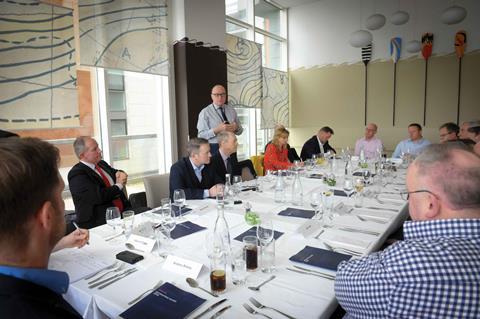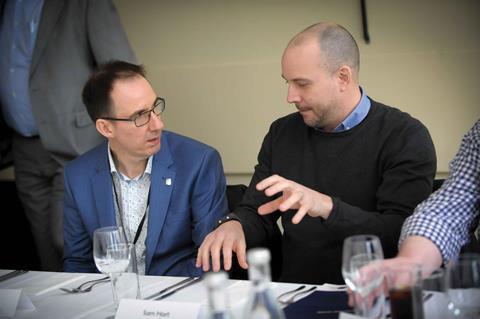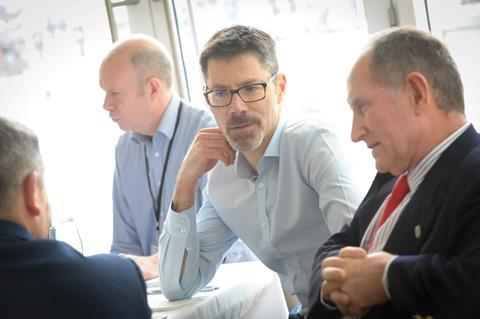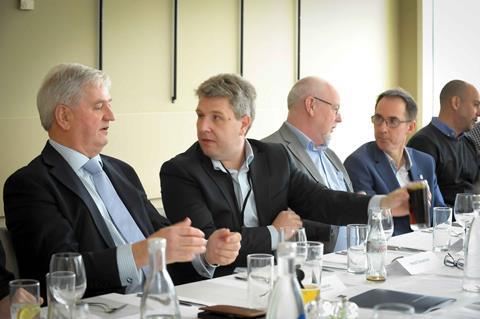Standards in construction clearly need to be raised â so how can the industry go about improving quality, and how exactly do we define it? Hamish Champ reports on a roundtable by the STA

Striving for quality in construction, not least in housing, has been a mantra ever since the first ever brick was laid. But customer confidence has been knocked in recent times as standards around build quality have been found wanting, even from some of those firms operating at the top end of the industry.
Added to this â and with the industryâs desire to meet the highest standards around safety, performance and building excellence uppermost in everyoneâs mind â government plans to restrict the use of combustible materials on certain buildings have prompted concern among many in the sector.
It was timely, then, that a roundtable discussion hosted by the Structural Timber Association (STA) and held earlier this month in London sought to share views on the issues of quality, safety and performance, including what a tightening of legislation might mean for new technologies designed to boost output, such as offsite manufacturing.
"We can measure cost in the construction industry, but much else around the quality thresholds is about perception"
Steve Green, Bouygues UK

What exactly is quality?
Chaired by Thomas Lane, șĂÉ«ÏÈÉúTV magazineâs group technical editor, the discussion kicked off around the subject of quality. Lane asked: what do people actually mean by quality, and what are the challenges in terms of delivering it?
Kevin Riley, laminated veneer lumber sales director at timber specialist Stora Enso and head of the STAâs PR committee, said quality ought to be âlooked at in the roundâ. Quality means different things to different people, he said, but âa key issue is eliminating inconsistencies in the end-product, not least given the strain on resources such as labourâ.
This idea that what quality means varies depending on whom in the sector one talks to became one of several themes throughout the discussion. Andrew Carpenter, the STAâs chief executive, said that very often the culture of the UK construction industry plays a part in both the perception of quality and eventual outcomes. âItâs our insistence on focusing on the lowest price which determines quality and a lot of the other issues we have to deal with. Iâd start with behaviours â and that means addressing procurement, which determines behaviours right the way through the supply chain,â Carpenter said.

"Itâll always be about price. Weâre not going to get away from that and say weâll pay any amount we like for it"
Robert Pannell, șĂÉ«ÏÈÉúTVs Hub
Short-termism is another key area, said Mark Stevenson, managing director of insulation specialist Kingspan and recently elected chair of the STA. âAre we thinking about what a building will look like in 40, 50, 60 yearsâ time? And how do you factor that into what quality is and how you ensure youâre building for longevity?â
For Robert Pannell, who works with housebuildersâ body NHBC and runs his own business, the șĂÉ«ÏÈÉúTVs Hub, the definition of quality is a combination of three elements: performance, aesthetics and cost. âThey have to be in balance with each other. It has to do the job, look good and be cost-effective. Itâll always be about price. Weâre not going to get away from that and say weâll pay any amount we like for it. Thatâs not going to happen.â
Having gained experience in an sector renowned for its focus on quality, namely the automotive industry, Peter Blunt, managing director of Innovare and STA Assure director, said construction could take a leaf out of other sectorsâ books. âWe talk about quality in subjective terms. In the automotive industry you can be objective around build quality, tolerances and the like. We can measure cost in the construction industry, but much else around the quality thresholds is about perception.â
"We need to assess what constitutes value before we can determine what quality looks like"
Andrew Carpenter, STA
Collaboration is crucial to the industryâs future as a deliverer of quality, believes Steve Green, Bouygues UKâs head of knowledge sharing: âYes, addressing procurement and behaviours is part of it. Mutual understanding ⊠the designer understanding what the contractor wants, the contractor understanding why the architect canât provide it, and then understanding what the supply chain wants and so on. If we donât get together to fix it collaboratively we wonât fix it at all.â

"The șĂÉ«ÏÈÉúTV Regulations [âŠ] are there for minimum standards for health and safety. They donât deal with quality issues"
Paul Everall, LABC
The issue of quality sometimes gets bound up with building regulations. But as Richard Whittaker, development director with affordable housebuilder WM Housing, pointed out, those regulations are merely prescribing the minimum that has to be achieved on a building site. âPeople have been trained to șĂÉ«ÏÈÉúTV Regulations standard as a minimum; they have skill tests which are higher than Build Regs standards. And they get out on site and all of a sudden the skills test standards have gone. Itâs about âWhat can I get away with?ââ
Paul Kempton, founder and managing director of insurance specialist Sennocke, said he believes șĂÉ«ÏÈÉúTV Control does not give assurances around a quality build. âIt said itâs âcompliant withâ. And that is a huge issue.â The other headache is a churn of staff among approved inspectors and local authorities, Kempton argued. âThereâs no new blood coming into the industry. Approved inspectors are earning more now not because theyâre doing a better job, but because of supply and demand.â
There is indeed a shortage of resources, acknowledged Paul Everall, chief executive of Local Authority șĂÉ«ÏÈÉúTV Control. âLocal authority resources have been squeezed a great deal over the years. Whether the șĂÉ«ÏÈÉúTV Regulations are right or not is another issue. They are there for minimum standards for health and safety. They donât deal with quality issues, although you can argue that they should.â
There is, said Everall, âa real opportunity for everyone to say what they think needs to be improved and how, and hopefully government will take those things on boardâ.

Can modular methods help?
șĂÉ«ÏÈÉúTVâs Thomas Lane then asked whether modular manufacturing could help solve some of the issues facing the sector. Everyone around the table agreed it would play an important role in the future but that there had been instances where some such methods had produced very poor-quality results. The consensus view was that it is no panacea, and the quality of the modular elements â especially an absence of defects â when they arrive on site is as big a part of their success or otherwise as what happens on site during their assembly.
Nic Clark, managing director of KLH UK and chair of the STAâs health and safety committee, said that for offsite manufacturing to be truly effective collaboration is essential. âAnd it demands earlier collaboration, earlier integration with the supply chain, hand-in-hand with BIM protocols, which offsite naturally lends itself to. You get the expertise delivered when itâs needed, and you can drive in the right detailing that can then flow through onto site. Youâre also getting the right price for the right product with the right levels of expertise at the right stage of the job.â
At this point the STAâs Carpenter brought up the subject of the Hackitt report, researched and written in the wake of the terrible fire at Grenfell Tower two years ago. Carpenter said Hackittâs findings present âa wonderful opportunity for us all. We need to talk about the asset management side of things. Getting the people who are going to run the building up front in the design process. Instead of measuring cost, we should be measuring outcomes and outputs. So that when we build hospitals they make patients better more quickly. We need to assess what constitutes value before we can determine what quality looks like.â

șĂÉ«ÏÈÉúTVâs Lane then highlighted the situation whereby once a building is finished and the keys are handed over it becomes a case of âhere endeth the problemâ as far as the industry is concerned. That prompted a discussion about proposed restrictions on certain materials deemed by politicians to be a high risk.
"The restriction wonât hit buildings under 18m. Thereâs no scientific, technical or other data available suggesting itâs an issue"
Alex Goodfellow, Stewart Milne Group
Alan Robb, a partner in cladding specialist Benx, said the outer shell of a building is often regarded as an afterthought, rather than being an integral part of the building process. Subjectivity around quality aside, people who live in a building âwant to be reassured that what theyâve got is going to last and do the job itâs supposed toâ.
So, is banning any combustible material as part of the wall structure an appropriate response, given the quality issues the industry is facing? Robbâs view is unequivocal: âThe problem is no one knows. Post-Grenfell everyoneâs trying to work out and cover every single angle in case something happens again. Itâs almost gone so far in the other direction that now people will reject something which makes no sense to reject, purely in the absence of certification.â

Suzannah Nicol, chief executive of trade body Build UK, argued that now is a pivotal moment for the domestic construction industry, with the collapse of Carillion, Grenfell and of course Brexit all combining to produce the perfect storm. The industry must do more to manage client expectations better, she said. âWhat does the client expect? What is the industry capable of delivering? Clients often want a Rolls-Royce but can only afford a Mini. As an industry weâre really good at saying âOK, weâll try and give you a Rolls-Royceâ, when what we should be saying is âIâll give you a fantastic Mini. Itâll do what you want, but it ainât a Rolls-Royceâ.â
Nicol believes Hackitt will force the industry to implement the changes needed to become more effective. âHer golden thread of brief, design, manufacture, how you buy, the sort of contracts that get drawn up, these are things we can work on. How the supply chain gets smarter, how cash flow gets smarter. We build amazing buildings despite the systems we have. Weâre doing something right.â Hackittâs golden thread was a âreally good summary of how accountability and passing the baton has to workâ, she added.
The question of quality on building sites and who is working on them was raised by KLH UKâs Clark. âI sometimes come away from a site so angry because of what Iâve seen. You need barriers to entry to stop certain products â but also certain firms â from getting into the market. As has been mentioned, we need to get away from the lowest-price culture, and clients have to take some responsibility too.â
Pannell said quality on site ultimately rests with the builder. âNot everything that starts off as an error ends up as a defect. Then thereâs communications and process. We fail drastically in the former and must do better to understand the latter. Processes vary hugely across different companies, and that can have an impact on quality.â

What materials can be used and where was another topic discussed. While acknowledging a fundamental need to improve in some areas, Alex Goodfellow, managing director of Stewart Milne Group, argued that a knee-jerk reaction to certain materials should be avoided at all costs. Any restriction on the use of those materials should be tested by the evidence, not by emotion, he said. âWe manufactured 9,000 homes in our factories in the past year and none were over 18m. Most of the 300,000 homes commitment from the government wonât be either.
âThe restriction wonât hit buildings under 18m. Thereâs no scientific, technical or other data available suggesting itâs an issue. I understand the response to Grenfell, absolutely. But we should always rely on science and data when deciding to build. Government has to take a lot on board before making a decision, but dismissing science, data and technical performance would not be anything Iâd wish to support,â Goodfellow added.
Matt Hoad, an architect with HTA, agreed, while noting the issue affects not only external structures but things going on inside a building as well. âWeâre going to continue using timber fire doors. Thereâs no question of changing from that; itâs a very well tested system, and youâve got to look at means of escape, everything, in a coherent review. Itâs wrong to pick on timber.â
And as Richard Whittaker said: âThe first recorded use of timber in construction in the UK was in 855BC. Of course itâs fit for purpose.â
How STA Assure ensures quality
A membersâ quality standard assessment, STA Assure is a scheme that offers reassurance to the construction community that its members meet or exceed current legislation and regulatory requirements across the structural timber spectrum.
Peter Blunt, STA Assure director and managing director of Innovare, said the industry has a responsibility to raise the bar itself, rather than rely on others: âThe purpose of STA Assure is to inspire confidence in all stakeholders in structural timber and how we do that through our members.â
Three key areas
There are three key areas, explained Blunt:
- Product compliance â proving a productâs suitability and being âright first timeâ
- Project quality â being âright on timeâ
- Process effectiveness â getting it âright every timeâ.
âWe want to build an understanding of the whole process,â he said. âItâs a combination of elements and there is no single silver bullet. Confidence in the product and in those who supply and install it is vital and we want to make sure structural timber is at the heart of that.â
The STAâs chief executive, Andrew Carpenter, agreed. He pointed out the association has worked on the Timberframe Competency Scheme with the CITB in recent years to make sure erectors are delivering to an agreed quality of best practice.
Proof of competency
âWe brought in a rule this year that all STA erectors have to have two-thirds of their personnel pass the competency scheme,â he said. âAnd STA manufacturers can only use STA erectors. The quality process is right through the chain. Weâve done the work with the CITB and have a similar scheme for manufacturers and designers and weâre about to go into an online testing programme to follow that all the way through the scheme.â
Itâs about giving confidence to everyone, Carpenter said: architects, contractors, clients. âWeâre confident in our direction of travel and that it will put STA Assure in that same place.
âWeâve an opportunity to put our house in order and be held up as an industry in possession of best practice. Help us to help you, by only using STA members.â

























No comments yet